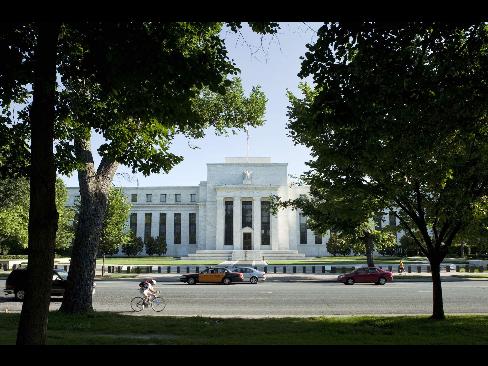‘In debt we trust’.

Traffic passes by the U.S. Federal Reserve building in Washington (Bloomberg)
July 23 (Bloomberg) — Treasuries declined, with 10-year notes falling the most in almost seven weeks, as stocks rose and the U.S. announced plans to sell a record $115 billion in notes in four auctions next week.
Yields on government securities rose as the Dow Jones Industrial Average touched above 9,000 for the first time since January. It will be only the second time the Treasury auctions three so-called coupon issues and an inflation-linked maturity in a single week since the U.S. started selling debt regularly in 1976 as the government accelerates an unprecedented pace of borrowing to stimulate the economy and service deficits.
“The unbelievable tension of the supply story, and a rally in the stock market — these combined to put pressure on yields, removing the flight to quality bid,” said Stewart Taylor, a senior trader who helps oversee $6 billion in investment-grade debt at Boston-based Eaton Vance Management.
The 10-year note yield rose 16 basis points to 3.71 percent at 3:12 p.m. in New York, according to BGCantor Market Data. That’s the most since it rose 19 basis points on June 5. The 3.125 percent security due May 2019 fell 1 1/4, or $12.50 per $1,000 face amount, to 95 1/4.
Thirty-year bond yields increased 15 basis points to 4.59 percent. Two-year note yields rose 10 basis points to 1.04 percent.
The U.S. plans to sell $6 billion in 20-year Treasury Inflation Protected Securities, $42 billion in 2-year notes, $39 billion in 5-year securities, and $28 billion in notes maturing in seven years. The auctions will be held over four consecutive days starting on July 27. The previous record was $104 billion in 2-, 5-, and 7-year notes sold the week of June 22.
Debt Sales
“The increase in issuance in the front end of the curve is the biggest surprise,” said George Goncalves, chief fixed- income rates strategist at Cantor Fitzgerald LP, another primary dealer. “There is a realization that you can’t rely only on the back end of the curve. It’s been creating talk of inflation.”
The government more than doubled note and bond offerings to $963 billion in the first half of 2009 as it tries to end the U.S. economic recession. It may sell another $1.1 trillion by year-end, according to primary dealer Barclays Plc.
“Taking down supply hasn’t been an issue, but it is another $115 billion in paper,” said Charles Comiskey, head of U.S. Treasury trading in New York at primary dealer HSBC Securities USA Inc. “That’s a lot of paper, so the market will have to find the right yield.”
Fed Purchases
President Barack Obama is depending on foreign investors like China as he sells record amounts of debt to stimulate the economy and service unprecedented deficits. China, the largest foreign holder of U.S. debt with $801.5 billion, added net $38 billion to its holdings in May, according to Treasury data. Russia, Japan, and Caribbean banking centers trimmed their holdings.
Demand from indirect bidders, whose ranks include foreign central banks, increased to 30.4 percent of debt sold through auctions this year, from 21.6 percent in 2008, according to data compiled by the Treasury Department.
Lower bond prices today may reflect investor concern that demand for Treasuries will be weak at current prices, said Eaton’s Taylor.
“You are already getting a concession in yields,” Taylor said. “If equities begin to struggle and don’t follow through, you will find plenty of demand at those auctions, but if they don’t, then who needs them? There will be plenty more coming.”
Lenders Supplement
The government and the Fed have spent, lent or committed more than $12 trillion in a bid to revive the economy and credit markets. The budget deficit this year is projected to reach $1.85 trillion, equivalent to 13 percent of the nation’s economy, according to the nonpartisan Congressional Budget Office.
The Federal Reserve bought $3 billion in 30-year bonds today, part of a program announced in March to cap borrowing costs by acquiring up to $300 billion of U.S. debt over six months.
The central bank has bought $219.72 billion in U.S. debt through its purchase operations, which began March 25. Ten-year note yields, at 3.62 percent today, are up from as low as 2.46 percent after the central bank’s March 18 announcement of the plan to buy long-term government debt.
The Fed’s purchases of Treasuries are supplemented by U.S. lenders. Bank holdings of government securities and debt of mortgage companies Fannie Mae in Washington and McLean, Virginia-based Freddie Mac totaled $1.33 trillion in the week ended July 8, the most since the Fed began compiling the figure in 1973.
Credit Markets
The U.S. savings rate rose to 6.9 percent in May, the highest level since December 1993, leaving banks with funds that they can funnel to the bond market.
A Bloomberg survey of banks and securities companies projects the yield will be 3.67 percent by Dec. 31, with the most recent forecasts given the heaviest weightings. The yield touched 3.72 percent on July 20, the highest level in almost a month.
The difference between rates on 10-year notes and TIPS, which reflects the outlook among traders for consumer prices, was 1.89 percentage points, widening from almost zero at the end of 2008. The spread has averaged 2.21 percentage points for the past five years.
Yields indicate the Fed is having success in thawing credit markets that froze last year.
The London interbank offered rate, or Libor, for three- month loans rose less than half a basis point to 0.504 percent today from 0.502 percent yesterday, according to the British Bankers’ Association. The Libor-OIS spread, a gauge of bank reluctance to lend, was also little changed, at 31 basis points.
To contact the reporters on this story: Susanne Walker in New York at [email protected]; Cordell Eddings in New York at [email protected]
Last Updated: July 23, 2009 15:18 EDT
Source: Bloomberg